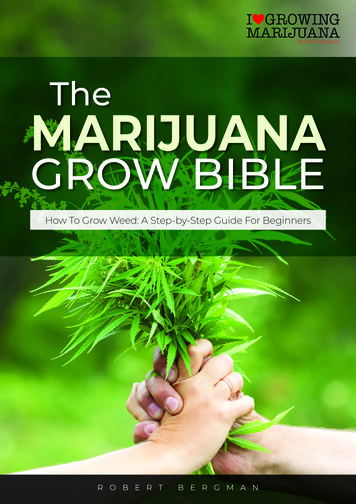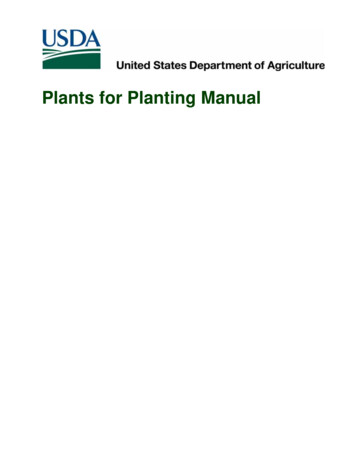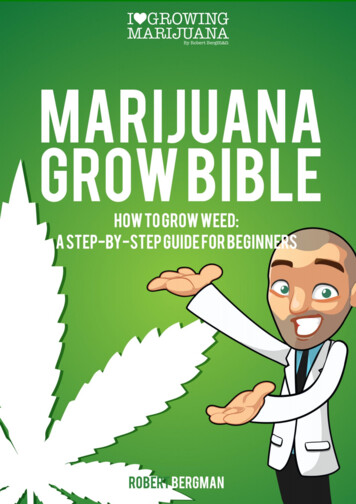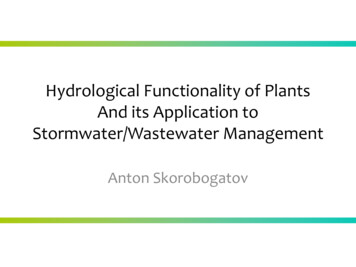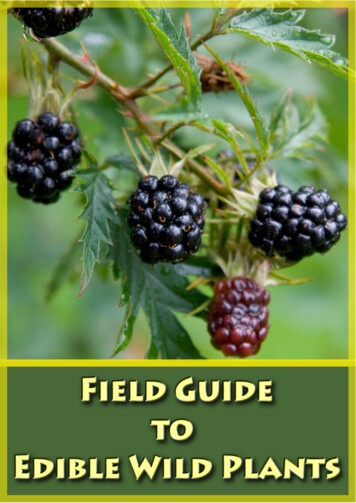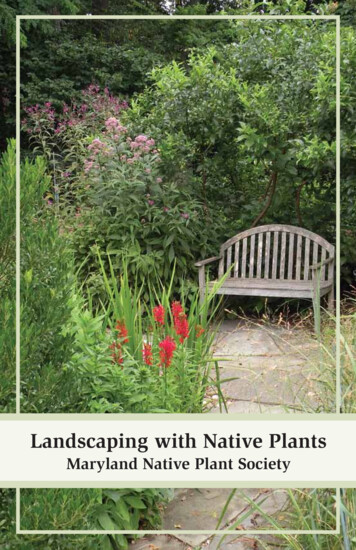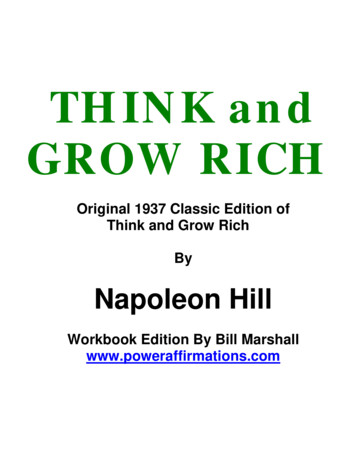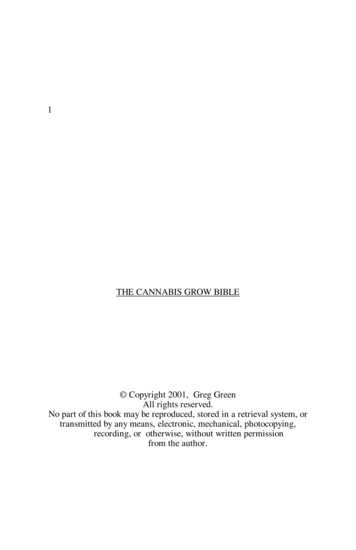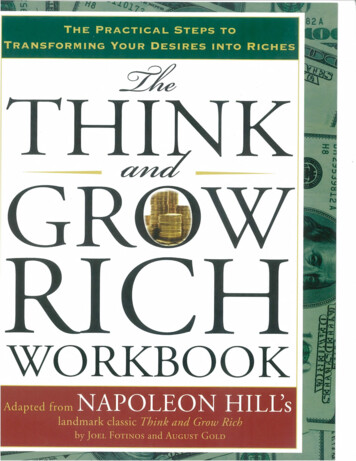
Transcription
3Plant Connections4H360What Makes PlantsGrowGrow?PURPOSE: To become familiar withwhat makes plants grow.LEARNING ACTIVITIESOBJECTIVES:For youth to: identify five basic plantneeds. describe what a plantneeds in order tomanufacture its own food. describe how the nutrientcontent of a soil can beimproved. describe a plants role in thehydrologic cycle. identify way plantscompete. associate plants habitatswith plant needs.2. LET'S EAT!LESSON TIME:Lesson time may varybased upon learningactivities selected. Mostactivities areapproximately 30 minutes.1. NEW BEGINNINGS3. GROW UP!4. KEEPING COOL!5. SURVIVAL OF THE FITTEST!6. PLANT HABITATSDOThe following are suggestions for using the activities in Lesson 3.The materials needed for each are listed within the activity. ADVANCE PREPARATION: Read the BACKGROUNDBASICS on What MakesPlants Grow? Review activities andchoose appropriate one(s)to use. Collect and preparematerials for appropriateactivities. Associate plant needs with plant growth in NEW BEGINNINGS. Explain how plants provide us with oxygen in LET'S EAT! Describe the importance of nutrients to plants in GROW UP! Explain the movement of water in the hydrologic cycle inKEEPING COOL! Identify ways plants adapt to their environment in SURVIVALOF THE FITTEST! Identify types of plant habitats in PLANT HABITATS.
REFLECTAfter completing the activities in this lesson, help youth reflect on what theyhave learned with these questions:What do plants need in order to grow?sunlight, water, air, proper temperature, nutrientsWhat is photosynthesis?food manufacturing process in green plantsHow do plants get their water and nutrients?absorption by the rootsWhy is water important to plant growth?used in photosynthesis, transports nutrients, regulatestemperature, keeps cells turgidWhat are some ways plants adapt to their environments?hard seed coats, chemical defense, thorns and spinesWhy do plants need space and shelter?overcrowded areas increase competition for growth limitinggrowth factorsyoung plants need shelter from harsh environmentalconditionsAPPLYHelp youth learn to apply what they have learned. Name the limiting factors that effect plant growth. Investigate how the structure and shape of a leaf affects photosynthesis. Start a compost pile!!! Follow the instructions on the COMPOSTINGinformation sheet. Find out what adaption desert plants have developed to minimize waterloss. Collect and identify seeds around your schoolyard. How was each seeddispersed? What are it’s chances of survival? Inspect an artificial habitat (vegetable garden, lawn, hedgerow). Discusswhat the plants need and how those needs are met.Plant Connections, Lesson 3Introduction
BACKGROUND BASICS . What Makes Plants Grow?The vital needs of a plant are very much like our own - light, water, air, nutrients, and a propertemperature. The relative importance of each of these needs differs widely among plants. The abilityof a plant species to spread throughout a geographic area is a direct result of its adaption to the abioticand biotic components of the area. Although most habitat components act on a plant simultaneouslyand should be considered together, the lack of one essential component can determine the health of aplant. This factor, whatever it may be, is referred to as a limiting factor. The concept of limiting factorsapplies to all aspects of a plant's interaction with its habitat. Any factor in the ecosystem can act as alimiting factor. For example, water is important to many species; most species cannot live in desertregions because of lack of water and most cannot live in marshes because of excess water. Extremetemperatures inhibit plant growth in many regions; lack of warmth in winter is a limiting factor thatkeeps many species restricted to the tropics.Another limiting factor is often competition from species that use the same resources.Competition is the principal interaction among plants. Plants of the same species are stronglycompetitive because they have the same requirements for sunlight, water, and nutrients.Environmental Factors Affecting Plant GrowthLightLight reaching the surface of a plant is either absorbed, reflected, or transmitted. Energy, in theform of sunlight is one of the driving forces in the chemical reaction known as photosynthesis.Photosynthesis is the process by which green plants manufacture food, mainly sugars, from carbondioxide and water in the presence of chlorophyll (a green pigment), utilizing light energy and releasingoxygen and water. Together the quality, quantity, and duration of light influences plant growth. Plantsgrown in direct sunlight are typically compact, where as those in shade are taller and elongated. Seedsmay start to grow (germinate) without light, but the plant growing from it must have light if it is tocontinue to grow.MoistureWater is essential for life, it is one of the most important requirements for plant growth. Wateris the main component in plants cells, it keeps the plant turgid (stiff), it is used in photosynthesis, andtransports nutrients throughout the plant. Plants also use water to lower leaf temperature, increasemineral absorption, and pull water from the roots to the top of the plants through a process known astranspiration.The hydrologic cycle. The hydrologic cycle is the cycle of water in the environment. Watermoves in a series of processes. Water moves by precipitation, evaporation, transpiration, andcondensation. The sun provides the energy for water to move in a cycle. All water on earth is part ofthe water cycle regardless if it is in a lake, our bodies, food, or underground. Precipitation (rain, snow,hail, etc.) either infiltrates the soil or runs into nearby ditches or streams. Water on the surface of a lakeor pool will eventually evaporate from the sun’s heat and become water vapor. This vapor thenbecomes part of a cloud and condenses to form precipitation. Plants release water vapor into theatmosphere by transpiration.Plant Connections, Lesson 3Introduction
AirOne of the raw materials used in photosynthesis is carbon dioxide. The content of carbon dioxidein the atmosphere is relatively stable at about 0.03 percent, a seemingly small amount but totalingroughly 2,000,000,000,000 tons in the atmosphere surrounding the earth. Carbon dioxide is continuallybeing added to the air by respiration of plants and animals, decaying organic materials, combustion offuels, and volcanic activity. Carbon dioxide diffuses through the stomata (pores or openings in a plantsepidermis) from the atmosphere into the intercellular spaces of the leaf.Wind is air in motion and can be both beneficial and harmful to plants. Wind can benefit plantsby accelerating the transfer of heat from leaf surfaces and increasing circulation in areas prone to fungalgrowth. Wind can be detrimental to plants by causing excessive drying, scattering of weed seeds, andsometimes destroying plants.Proper temperatureThe temperature of the atmosphere is the result of the transfer of heatfrom the earth’s surface to the surrounding air. Temperature varies with latitude,altitude, and topography. The climate and temperature of an area determineswhat kinds of plants will grow. The ability of a plant to withstand coldtemperatures is known as cold hardiness while plants that can not tolerate coolweather are known as tender. In the natural environment, temperature iscontinually changing.NutrientsIn addition to carbon dioxide and water, plants need 17 different nutrients to maintain growth.Although carbon, oxygen, and hydrogen are obtained from the air, most nutrients that a plant needsmust be present in the soil or growing medium. These elements are divided into macro and microelements. Macro nutrients needed in the largest amounts are nitrogen (N) for healthy foliage,phosphorus (P) for flower development, and potassium (K) for root growth.The soils in which plants grow consists of a mixture of mineral materials, organic matter, water,and air in varying proportions. The small fragments of mineral materials are derived from rock overlong periods of weathering. The organic matter consists of living organisms, their excretions, and decayproducts. The texture of soils refers to the sizes of the particles that dominate. The texture of a soilinfluences the amount of air, water and nutrients held in the soil. In general, the penetration of air,water, and roots occurs much more readily through soils in which large particles (sand) dominate. Onthe other hand, water-holding capacity and fertility are mainly a result of small particle size (silt andclay) and organic matter.Plant Connections, Lesson 3Introduction
Activity 1:New BeginningsOBJECTIVES:For youth to: identify five basic necessities to plantlife. describe limiting factors of plants. associate plants needs with plantgrowth.LIFE SKILL: Acquiring, analyzing, interpreting andusing data.MATERIALS: copies of HOW PLANTS GROWinformation sheet for each youth copies of TREATMENT and CONTROLData sheets for each group 10 bean plants (2 per group) paper towels water 10 pots or cups with holes in bottom potting soil and sand for the 10 plants clear plastic bag large paper bag water soluble plant foot rulers pens or pencils Copies of INDOOR GARDEN Activityand supplies (optional) shallow container (1/2 to 1 footdiameter) potting soil and gravel 1 cup granular fertilizer (6-6-6 or 88-8) small plants (English Ivy,Philodendron, Pepperomia, Hoya) water masking tape markersTIME: 30 minutes 15 minutes every three days or fourdays to record dataSETTING: A comfortable room with tables andchairs and access to a freezer.INTRODUCTIONPlants need five things in order to grow: sunlight, propertemperature, moisture, air, and nutrients. These five things areprovided by the natural or artificial environments where the plantslive. If any of these elements are missing they can limit plantgrowth. What do you think would happen if you limited theamount of sunlight or water given to a plant? Today, we're goingto start an experiment to see exactly what happens to a plantwhen one of these five elements is missing.ADVANCEPREPARATION:Preparation can be done by either leader or youth. This is anopportunity for youth to learn additional plant concepts such asimbibition (uptake of water and swelling of a seed), germination(growth of a seed embryo), and transplanting (transfer ofseedlings). Start bean plants three to four days before theexperiment. Green, pole, and lima beans work well.To help youth see the process of seedling roots , place twentyseeds on a plate between moist paper towels. Keep the papertowels damp. The seeds will germinate in two to four days, evenwithout light.To prepare for the experiments, plant seeds in small pots or cupsusing a mixture of 1/4 potting soil to 3/4 sand. Using a greaterproportion of sand will enable the nutrient and moisture groups todetect noticeable differences within the experimental time frame.Plant Connections, Lesson 3Activity 1
DO Select several youth to read HOW PLANTS GROW Information sheetaloud. Divide youth into five groups: sunlight, temperature, moisture, air, andnutrients. Assign two plants to each group. Have groups label the plants with theirgroup name and a C for control or T treatment. Example: C Air and T Air. Give each group copies of the CONTROL and TREATMENT Data sheets, aruler, and pencil. Have each group record data on their control and treatment plants in thefirst blank column on their data sheets. Review the instructions onmeasuring plant height with youth. Read the experiment instructions aloud to youth:Control Plants Each group will place their control plant in a windowsill. Water orfertilize when the soil is dry to the touch (probably every three to fourdays).Treatment Plants The sunlight group will place a paper bag over their treatment plant.Water or fertilize when needed. The temperature group will place their treatment plant in a freezer.Water or fertilize when needed. (Although light will be excluded whenthe freezer is closed, the idea is for the plant to freeze and die due toimproper temperature conditions.) The moisture group will place their treatment plant in a windowsill andwithhold water. Apply only dry fertilizer. The air group will place their treatment plant in a clear plastic bag andtighten the bag around the plant so no air is let in or out. Place theplant in a partly shaded area so the plant won't overheat. Water orfertilize only when needed, try to minimize the amount of time the bagis open. The nutrient group will place their treatment plant in a windowsill andwithhold plant food. Apply only water when needed. Every three to four days the groups will examine their plants and recordtheir observations on the data sheets. At this time the control andtreatment plants should be given water or nutrient solution. Once the data sheets have been completed (2 to 3 weeks) have groupspresent a control/treatment comparison report to the class.Plant Connections, Lesson 3Activity 1
REFLECTWhat five things do plants need in order to grow?light, moisture, air, temperature, and nutrientsWhat were the limiting factors used in the experiment?blocking the sunlight, lack of moisture, keeping out the air,improper temperature, withholding nutrientsWhat were the differences between your control and treatment plants?answers will varyDo you think that any one of the five elements that a plant needs are moreimportant than another? Hint: Have groups compare the health of theirtreatment plants.answers will varyWhy do we use a control group in the experiment?its used as comparisonAPPLY Where do plants in the environment get the basics they need to grow?sunlight, rain, soil Where do indoor plants get the basic elements they need to grow?we provide them through fertilizing, water, etc. Can you name limiting factors that might affect your growth?lack of food or water Create a dish garden or terrarium using the INDOOR GARDEN Activity.Plant Connections, Lesson 3Activity 1
How Plants GrowInformationMany things in nature help to regulate plant growth: sunlight, proper temperature, moisture, air, andnutrients. These are referred to as environmental factors. Each part of a natural or artificial environmentaffects the survival and quality of a plants life. Knowing the basic facts about the way in which plants liveand grow will help you understand plants.Light: All living things, except for a few groups of bacteria, depend on photosynthesis for theirexistence. Photosynthesis is the process by which green plants make their own food. In the presence oflight energy, plants manufacture food (mainly sugars), by combining carbon dioxide and water in thepresence of chlorophyll to release oxygen and water.Proper Temperature: Temperature is the most important environmental factor affecting plant growth.Plants vary in their temperature needs. The ability of a plant to withstand cold temperatures is known ashardiness. Plants that cannot tolerate cold weather are known as tender plants.Water: Water is essential for life. It is one of the most important requirements for plant growth. Wateris the main component of plant cells, it keeps the plant turgid (stiff), it's used in photosynthesis, and ittransports nutrients throughout the plant.Air: The manufacture of carbohydrates and proteins which a plant needs to live and grow requires rawmaterials. These materials are either found naturally in the environment or supplied by the grower.Plants absorb the raw material carbon dioxide from the surrounding air and use it in photosynthesis.Nutrients: Although plants are able to use a few nutrients from the air, most of the nutrients that aplant needs must be present in the growing medium (soil). Minerals such as nitrogen, potassium,phosphorous, calcium, and magnesium are taken up through the plant's roots.Measuring Plant Height5.0cm6.2cmPlant Connections, Lesson 3Activity 1
Control PlantGroupName:Date:Date:Date:Date:Date:Group Members:(List names)Height (inches)Height (centimeters)Number of LeavesColor of PlantGeneral AppearanceOther CommentsPlant Connections, Lesson 3Activity 1
Treatment PlantGroupDate:Date:Date:Date:Date:Group Members:(List names)Height (inches)Height (centimeters)Number of LeavesColor of PlantGeneral AppearanceOther CommentsPlant Connections, Lesson 3Activity 1
Indoor GardenThe object of creating an INDOOR GARDEN is to create an artificial environment that providesyour plants with their basic needs.To make your Indoor Garden you will need: shallow container (1/2 to 1 foot in diameter) soil or other potting medium drainage material like small rocks or gravel fertilizer (6-6-6 or 8-8-8) small plants (English ivy, philodendron, pepperomia, hoya)WHAT YOU DO:1. Place half to one inch layer of the drainage material in the bottom of the container.2. Mix one teaspoon of fertilizer to two quarts of soil and fill container to within one inch of thetop.3. Transplant the small plants in the container.4. Water lightly.Plant Connections, Lesson 3Activity 1
Activity 2:Let’s Eat!OBJECTIVES:For youth to: define photosynthesis. describe what a plant needsin order to manufacture itsown food. explain how plants provide uswith necessary oxygen.LIFE SKILL: Acquiring, analyzing, andusing information.MATERIALS: copies of THE GROWINGPROCESS Data sheet foreach group copies of THE GROWINGPROCESS Study questionsfor each group four plants (can bephilodendron, bean, or grass) two clear plastic bags withtwist ties two rulers poster paper colored markers pencils and pens masking tapeTIME: 25 minutes to introduce andset up the experiment 1 week later, 40 minutes toobserve and discuss resultsSETTING: A comfortable room withtables and chairs.INTRODUCTIONAll living things, except for a few groups of bacteria, depend onphotosynthesis for their existence. Photosynthesis is the processby which green plants make their own food. Plants manufacturefood, mainly sugars, from carbon dioxide and water in thepresence of chlorophyll, utilizing light energy and releasingoxygen gas and water. Chlorophyll is the green pigment in theleaves of plants that absorbs light energy and enablesphotosynthesis to take place.The process of photosynthesis is described as (write on poster orchalkboard):light6CO2 12H2O------------- C6H12O6 6O2chlorophyllSix molecules of carbon dioxide and twelve molecules of waterreact in the presence of chlorophyll and light to form onemolecule of sugar and six molecules of oxygen. Today we're goingto start an experiment where we change the photosynthesisequation by reducing the amount of carbon dioxide available to aplant. Let's get started!DO Divide youth into two groups. Give each group two plants (all same species). Have groupslabel plants as follows:Group #1: Sun/With Bag Sun/Without BagGroup #2: Dark/With Bag Dark/Without BagPlant Connections, Lesson 3Activity 2
DO (continued) Give each group a copy of THE GROWING PROCESS Data and Studyquestion sheets. Measure and record the height (in centimeters) and appearance of eachplant. Enclose the plants labeled Sun/With Bag and Dark/With Bag in clear plasticbags and tighten to remove excess air from around the plants. Group #1 should place both plants in a sunny location. Group #2 shouldplace both their plants in a dark location. After one week, measure and record the height and appearance of eachplant. Have groups graph their results and present a brief discussion of theirfindings.REFLECTWhat is photosynthesis?food manufacturing process of green plantsWhat is produced during photosynthesis?sugar, oxygen, waterWhere does the carbon dioxide in the equation come from?people and animals exhale carbon dioxide, plants andburning fossil fuelsWhat role does chlorophyll play in the process?chlorophyll absorbs light energy needed for photosynthesisHow did we limit carbon dioxide and light energy from the plants?carbon dioxide was limited by the bag and light energy waslimited by placing a plant in a dark areaWhat do the plants in the sunny location look like?the plant labeled “Sun/Without Bag” should look healthy andgreen, the plant labeled “Sun/With Bag” may have a wiltedappearance and should have condensation on the inside ofthe bag.Plant Connections, Lesson 3Activity 2
REFLECT (continued)What do the plants in the dark look like?the plant labeled “Dark/Without Bag” may have elongatedstems and a yellow (chlorotic) appearance. The plant labeledDark/With Bag should appear yellow and wilted withcondensation on the inside of the bag.What would happen in the photosynthesis equation if you leave the plantlabeled “Sun/With Bag” in the bag?the plant would eventually use up the carbon dioxide in thebag and photosynthesis would stopWhat would happen in the photosynthesis equation if you leave the plantlabeled ”Dark/With Bag “in the bag?photosynthesis would stop due to the lack of light andcarbon dioxideAPPLY Besides humans and animals exhaling, what else produces carbon dioxide?burning fuel, cars, buses, factories and plants How does the structure or shape of the leaf affect photosynthesis?Leaf shapes are usually broad, flat, and thin to ensuremaximum exposure of the leaf to light. Let's think in terms of the big picture or the world view: The amount ofpeople on the earth is increasing and forests are being cut to makeproducts and places for people to live. The levels of pollution in ouratmosphere are also increasing. What does this mean in terms of theamounts of oxygen and carbon dioxide in the atmosphere?an increase in carbon dioxide would benefit plants since it isneeded for photosynthesis. Fewer plants and more carbondioxide would increase pollution in the atmosphere. Fewerplants would mean less oxygen available for us to breathe.Plant Connections, Lesson 3Activity 2
The Growing ProcessData SheetWhat is the height of each plant?Group #1Group #2BeginningFinalSun/With Bag cmcmSun/Without Bag cmcmDark/With Bag cmcmDark/Without Bag cmcmWhat does each plant look like? Monitor your plants every 3-4 days.AppearanceGroupBeginning (Day 1)Day 3Final ObservationSun/With BagSun/WithoutDark/With BagDark/Without BagPlant Connections, Lesson 3Activity 2
The Growing ProcessStudy QuestionsAnswer after the experiment to help organize group presentations.1. How do the plants (in your group) differ in height from the beginning to the end of the experiment?Can you explain the differences?2. How do the plants (in your group) differ in appearance from the beginning to the end of theexperiment? Can you explain the differences?3. Was there a difference in the plants with and without a bag?4. How did your group’s results compare to the other group’s findings?Plant Connections, Lesson 3Activity 2
The Growing Process ResultsHeight (cm)Graph your results below:Day 1Plant 1With BagPlant 2Without BagDay 3Plant 1With BagPlant 2Without BagFinal ObservationPlant 1With BagPlant 2Without BagPlant Connections, Lesson 3Activity 2
Activity 3:Grow Up!OBJECTIVES:For youth to: describe the importance ofnutrients to a plant. explain the nutrient and waterholding capacity of soils. describe how the nutrientcontent of a soil can beimproved.LIFE SKILL: Problem solving and decisionmaking.MATERIALS: copies of GROW UP! Data sheetfor each group four corn or bean plants grownin varying types of soil four rulers two 1-liter plastic bottles withends removed two mayonnaise jars or beakers copies of COMPOSTINGInformation sheet for eachyouth pens or pencils copies of COMPOSTINGMAKES SENSE activity for eachyouth (optional)TIME: 30 minutesSETTING: A comfortable room with tablesand chairsADVANCE PREPARATION: Grow four corn or bean plantsfive weeks before experiment.Each plant should be grown in adifferent soil type (e.g. sand,clay, potting soil, and a mixtureINTRODUCTIONHave you ever thought of soil as a living thing? Soil is a storehouseof animals, decaying vegetation, moisture, and nutrients. Plantroots uptake water and nutrients held in this storehouse. Althoughplants are able to use a few nutrients from the air, most of thenutrients that a plant needs must be present in the soil. Today,we're going to see how plants grow in different types of soil.DOHow plants grow in different soil types: Divide youth into four groups. Give each group a copy of the GROW UP! Data sheet, a ruler,and a plant. Have groups record the plant's height (in inches andcentimeters) and general appearance on their data sheet. Repeat data measurements over the next 3 weeks. Have groups answer the questions at the bottom of the datasheet. Discuss the results with youth.Water holding capacity of soils: Remove the bottom from two 1-literclear plastic bottles. Fasten a piece of cloth (cotton orcheese cloth) over the small end withrubber bands. Fill bottles half way with equalamounts of soil (one with sand andthe other with clay).Plant Connections, Lesson 3Activity 3
Place the bottles over a mayonnaise jar or beaker. Add an equal amount of water to each container (about half a cup). At the end of 5 or 10 minutes measure the amount of water that hasseeped through each soil type and into jars. Discuss the results with the youth.REFLECTWhat are some basic plant needs?air, water, nutrients, light, and temperatureHow do plants get water and nutrients into the plant?the roots absorb themHow does the type of soil affect a plants growth?soils that lack appropriate amounts of nutrients and watercan limit growthHow does soil type affect its ability to hold water?large soil particles (sand) allow water to quickly drain out ofthe soil while smaller soil particles (clay) hold moisture in thesoilHow could you improve the nutrient content of a soil?add nutrient rich soil, compost, or fertilizer to an areaDo you need soil to grow plants?no, plants can be grown in soilless media (vermiculite,sphagnum, perlite), water, nutrient solutionsAPPLY Make a list of ways in which soil is important to us. Start a compost pile!! Follow the instructions on the COMPOSTINGinformation sheet. Why is it necessary to add fertilizers to an area where crops have beengrown for years? Complete the COMPOSTING MAKES SENSE activity.Plant Connections, Lesson 3Activity 3
Grow Up!Data SheetHow plants grow in different soil types:Soil TypeDate:Height 1(cm ) (inches)Date:Height 2(cm ) (inches)Date:Height 3(cm ) (inches)Appearance 1Appearance 2Appearance 3SandClayPotting SoilMixtureSoil TypeSandClayPotting SoilMixturePlant Connections, Lesson 3Activity 3
Questions to be answered after the experiment1. Which plant grew the most? the least?2. How did soil type effect the plants' growth?3. Did you notice any other differences in the appearance of the plants?4. Which soil type contains the most nutrients?Graph the results:Plant Connections, Lesson 3Activity 3
Composting InformationComposting is the controlled decomposition of organic materials by bacteria, fungi, worms, and otherorganisms. Decomposition is a natural process that has occurred since the beginning of time.Composting just manipulates this natural process. Decomposition and recycling of organic wastes arean essential part of soil building and healthy plant growth in forests, meadows, and in your garden.How to Compost1. Place the compost pile in a partially shaded area where it will be comfortable for you to "work" thepile (turn and water it).2. Layer yard wastes in the composting pile. Start by placing brown materials like twigs and leaves onthe bottom of the pit, this will hold the pile off the ground and aerate it. Then add a layer of greenmaterial like grass clippings, food scraps, or fertilizer to provide a food source rich in nitrogen fororganisms. Nitrogen gives organisms energy to decompose tough carbon-laden materials likeleaves and wood.3. Mix in a shovel full of soil. Soil contains micro-organisms and other soil animals that make thecompost., although the leaves and other materials you add are also loaded with microorganisms.4. Continue to add ingredients and you should have a 4 foot pile with layers of brown and greenmaterials.5. Your pile should be damp to the touch but not so wet that drops come out when you squeeze it.6. Mix your compost about once a week. And watch.when your compost is ready, it will look likedark crumbly soil and have an earthy smell.What Can Be Composted?DO'sgrass clippingsbanana peelsegg shellsorange peelsflowerstwigsleavesweeds (without seeds)manure (cow, horse, chickens)The do's and don'ts of composting.DON’TSdiseased plantsseedsmeats and oilsmanure( if from meat-eating animals likecats, dogs, pigs)Plant Connections, Lesson 3Activity 3
Composting Makes Sense Composting reduces yard waste. Composting improves soil and keeps your plants healthy. Compost provides food for beneficial soil organisms. Can you think of other reasons composting makes sense?N DECZBO AFO M POSEIXKSM TFIUOW OR M EVEPO HCUIEE W TOEYHN ORCDSSDAFGEBUJATPSOILKDIW ATERSIPEEYTDBKYPDRECYCLEGFCHWord SearchFind these compost-related UCEREUSESOILWASTEWATERWORMSolve this maze tohelp Mighty Mikefind his food:Plant Connections, Lesson 3Activity 3
Activity 4:Keeping Cool!OBJECTIVES:For youth to: list the importance of water inplant growth. describe a plants role in thehydrologic cycle. define transpiration. explain the movement of waterin the hydrologic cycle.LIFE SKILL: Acquiring, analyzing, and usinginformation.MATERIALS: wilted plant copies of KEEPING COOL!Activity Sheet for each group copies of HYDROLOGIC CYCLEActivity sheet for each youth 6 small clear plastic bags 6 rubber bands thermometer 100 ml graduated cylinder pens and pencilsTIME: 45 minutesSETTING: A comfortable room with tablesand chairs. Outdoor area withsun and shade plants.SUGGESTIONTo demonstrate wilting and turgidity:Bring a wilted plant into the room.Ask youth what they think is wrong with the plant.Water the plant and set aside.After the a
Light . Light reaching the surface of a plant is either absorbed, reflected, or transmitted. Energy, in the form of sunlight is one of the driving forces in the chemical reaction known as photosynthesis. Photosynthesis . is the process by which
